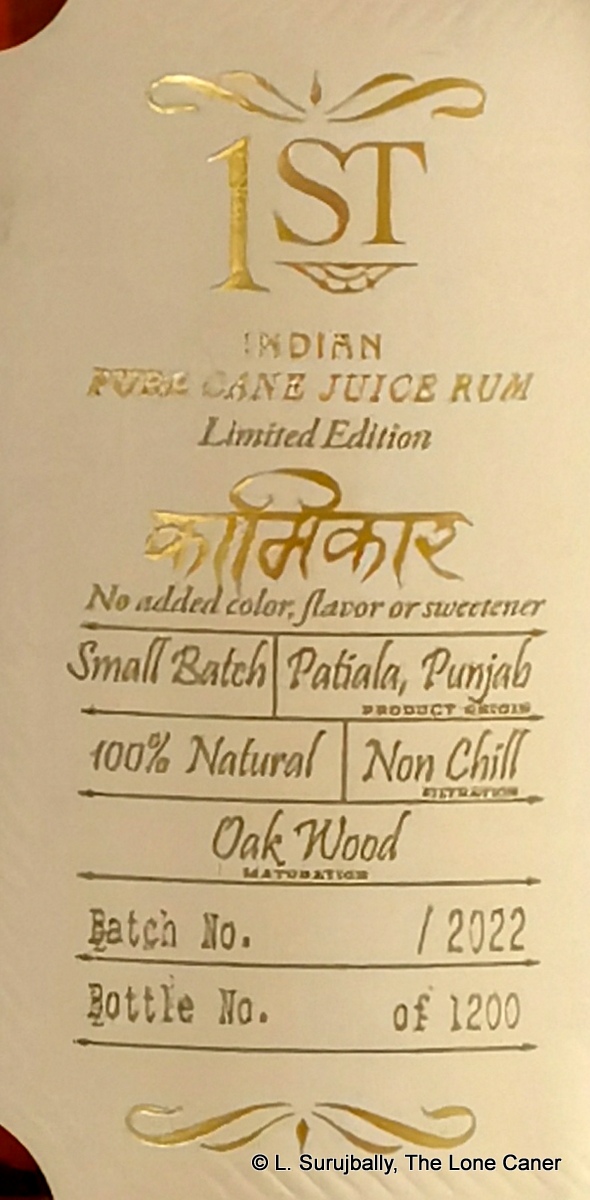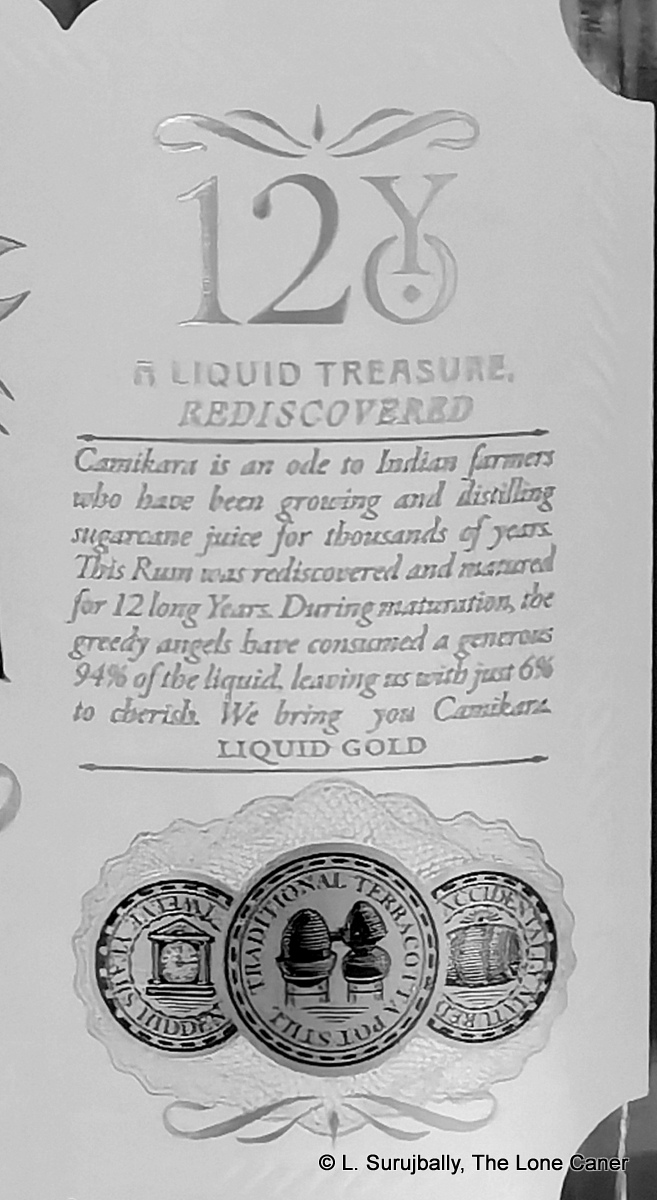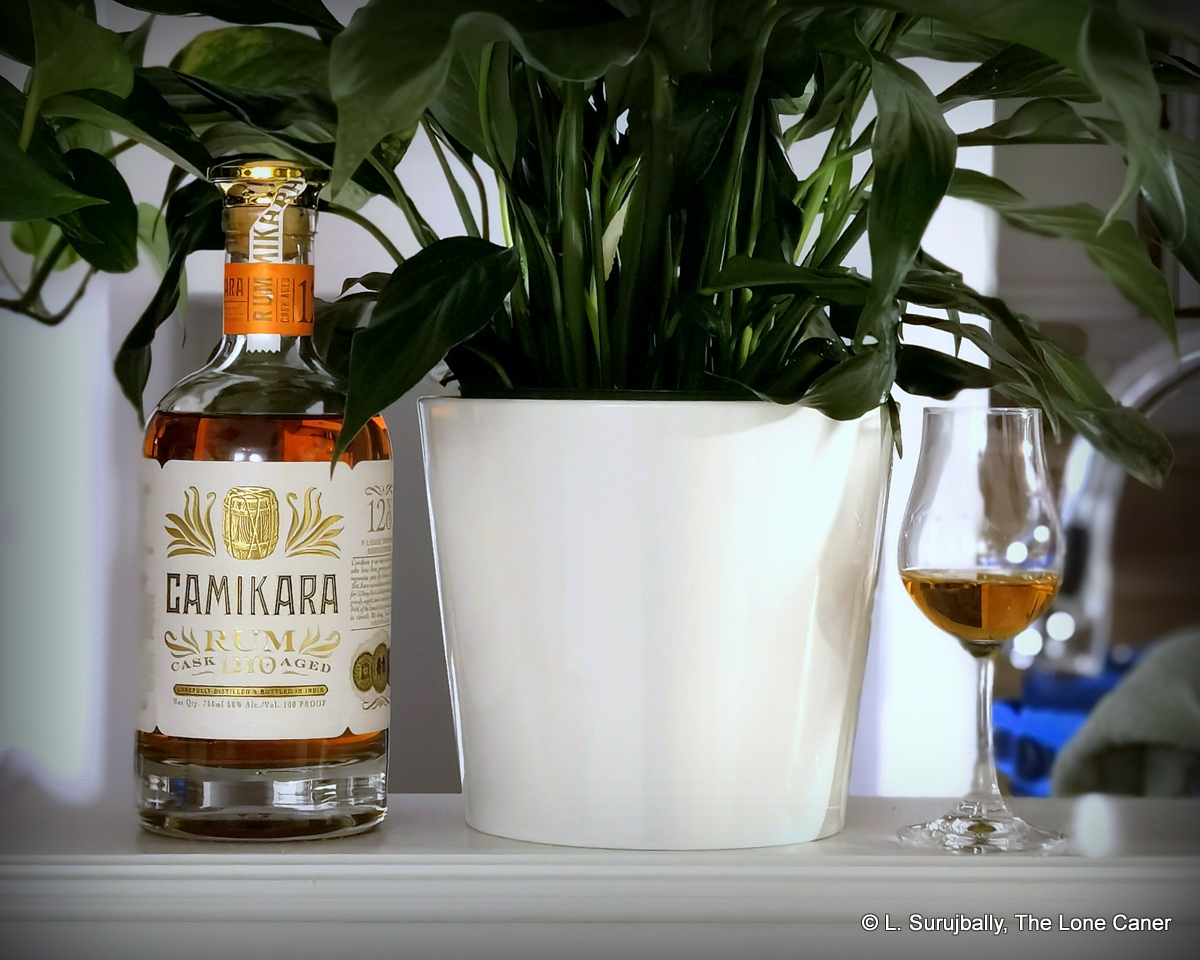A few months ago I posted a picture of what I was tasting that week on Instagram which included the Camikara 12 YO: I was surprised and pleased at the responses which said how much people had liked it — most of these came from those who had sampled it at that year’s UK rum festival. This is an export rum from India which has two younger siblings (a 3YO and an 8YO) and remains a rather unknown quantity to many, perhaps because they have all been issued quietly and without the serious social media fanfare as attends so many other rums these days, and been reviewed by too few.
 Yet I think we’d better start paying some attention, because this rum presses a number of buttons that, had they been made in more familiar climes by more familiar names, would have had us checking it out almost by default. Consider: here is a rum from a single cane varietal, made from cane juice (not jaggery or molasses), pot still distilled, aged for twelve years and bottled at a solid 50% ABV. Plus, it’s from India which, while having a great record in whiskies, does not have a stellar reputation for rums, yet which has on occasion surprised us with products of uncommon quality.
Yet I think we’d better start paying some attention, because this rum presses a number of buttons that, had they been made in more familiar climes by more familiar names, would have had us checking it out almost by default. Consider: here is a rum from a single cane varietal, made from cane juice (not jaggery or molasses), pot still distilled, aged for twelve years and bottled at a solid 50% ABV. Plus, it’s from India which, while having a great record in whiskies, does not have a stellar reputation for rums, yet which has on occasion surprised us with products of uncommon quality.
Piccadily Distillers made this rum in Haryana, a northern Indian state – it abuts the Punjab, and is just due south of Solan: those with long memories may recall that this is where Mohan Meakin of Old Monk fame started things going back in the 1800s. Piccadily themselves are better known, especially in India, for their malt whiskies Indri and Whistler and it’s never been made clear exactly why they would branch out into rums on an international scale, though my own impression is the market in India is simply too crowded with ersatz rums already, and increasing premiumisation of the spirit in the West suggests an opportunity to break into that market with an unusual product from a near-unknown location.
So that’s the background: what about the rum?
Nosing it suggested that the company has dispensed with most of the subtly and never-quite-proved flavoured profiles of Mohan Meakin’s Old Monk line and (to a lesser extent) Amrut’s own export rums. This stuff is not bad at all – initially quite tart and fruity, with canned peaches and yellow mangoes blending nicely with laban and the faintest whiff of sour cream. This is followed by aromas of red grapes and apples in a pleasantly clean and just-shy-of-light series of smells that feel quite crisp, while at the same time balanced off with caramel, plums, aromatic tobacco, vanilla and green peas. The sweetness that one senses is kept very much under control which stops any one aspect of the nose to predominate.
What is somewhat surprising is the strength – we have not seen a rum from India that clocks in at 50% before (though they have been edging up of late, with the 60+% Habitation Velier Amrut being something of an outlier). This provides the taste with a firm landing on the palate, starting off with flambeed bananas, peaches, red guavas, green peas and those overripe mangoes. What distinguishes this phase of the experience is the spice-forward nature of the rum: one can with some effort make out vanilla, cinnamon, ginger, tumeric and sweet paprika, and it brings back fond memories of the spice markets in middle-eastern soukhs more than anything else. There are some hints of salted chocolate, honey, cardboard, dusty cupboards, cheerios, and the rum presents as heavier than the nose had initially suggested…but it’s pretty good, and the closing notes of damp port-infused tobacco, honey anise, herbs, citrus and (again) spices makes for a fascinating segue away from more familiar profiles.
 I say “more familiar profiles” but really, this is a rum through and through and there’s no mistaking what it is. However, it must be stated that its agricole-style cane juice origins are somewhat lost in the middle of such long hot-weather ageing – the barrels do most of the heavy lifting of the profile, rather than the intrinsic nature of the cane juice distillate, which provides so much character to unaged whites from wherever – if Piccadily ever made such a white I’d be clamouring to get some. Moreover, my hydrometer tests this at 47.5% ABV, which works out to about 12g/L of something, so readers should take that into account – my own take is that it still tastes pretty good, but obviously that will not be everyone else’s opinion.
I say “more familiar profiles” but really, this is a rum through and through and there’s no mistaking what it is. However, it must be stated that its agricole-style cane juice origins are somewhat lost in the middle of such long hot-weather ageing – the barrels do most of the heavy lifting of the profile, rather than the intrinsic nature of the cane juice distillate, which provides so much character to unaged whites from wherever – if Piccadily ever made such a white I’d be clamouring to get some. Moreover, my hydrometer tests this at 47.5% ABV, which works out to about 12g/L of something, so readers should take that into account – my own take is that it still tastes pretty good, but obviously that will not be everyone else’s opinion.
Summing up, then, I must say that as a whole, taking everything into consideration, the Camikara rum is a treat: even in the controlled environment of my study, I admired it (in company even more so) and am now sharing it with everyone I can, because noses well and tastes great with just enough originality and uniqueness to the profile to make one take a second look and maybe a third sip, and it deserves a wider consideration. Like many rums from parts of the world other than the standards, while the DNA is unmistakable, the variation is really kind of fascinating. I think it’s a solid addition to the mostly unknown slate of aged rums from Asia generally and India in particular.
(#1037)(87/100)
Full disclosure: in early 2023 I was approached about taking a look at the 12YO by the head of Piccadily’s international business. He admitted they had no distribution in Canada and no facilities to get paid for a bottle, as is my practise: he offered to send me one if I could spot him dinner and a pint when next we were in the same area of the world. I consider that a firm deal, but since I have (as of this writing) not been able to make good, you should be aware of the source.
Other notes
- Camikara means “liquid gold” in Sanskrit
- The press blurbs talk about 956 barrels being laid to rest in 2009, of which only 6.6% remained twelve years later. Well, that works out to around 14,000 litres, so given its limited edition marketing (3600 bottles total, with 400 bottles to India, 1200 for the US, 400 for the UK and 800 for Europe), some has probably been left behind to age even further, and / or been blended into the younger releases.
- I like the whole origin story of barrels being overlooked and fortuitously “rediscovered” but consider the neglect and forgetting of nearly a thousand barrels to be ultimately unrealistic outside a press release, where anything goes.
- Piccadily Distilleries is part of the Piccadily Group, which has three distilleries in the Northern part of India: Indri, Patiala, and Bawal. The distillery making the rum is unclear: Mr. Siddhartha Sharma in an interview with Rumporter says Indri, while Surrinder Kumar the company’s master distiller, said it was Patiala in an interview with MoneyControl (he notes it was when the Patiala plant was being refurbished that the barrels were rediscovered) – it is the latter that is on the label, but I do wonder at the confusion.
- The company’s copper pot stills are Indian made.

No Responses to “Piccadily Distillers Camikara 2009 12YO Rum (India) – Review”